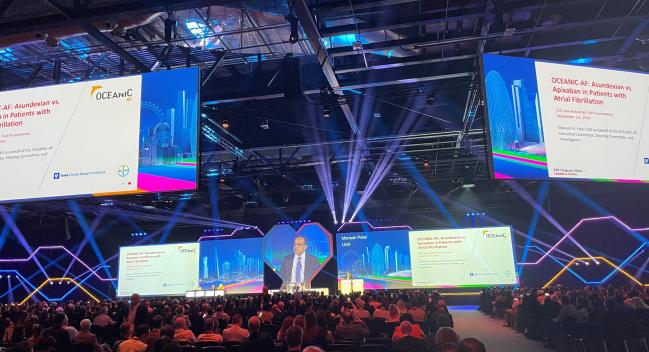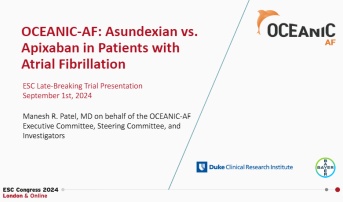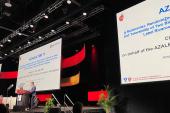Asundexian for AF? More Details on the Sinking of OCEANIC-AF
Discussion at ESC 2024 centered on questions of dosing, patients, and appropriate targets for this novel antithrombotic.

LONDON, England—Full results from the OCEANIC-AF study testing asundexian in atrial fibrillation (AF) patients at risk of stroke were released Sunday at the European Society of Cardiology (ESC) Congress 2024, answering some questions but leaving others unresolved.
As previously reported by TCTMD, Bayer, the trial sponsor, stopped the phase III OCEANIC-AF trial when enrollment had reached just shy of 15,000 of the intended 18,000 patients due to “inferior efficacy” of the study drug against apixaban in patients with AF at risk for stroke.
Asundexian, which inhibits factor XIa, is one of a new class of investigational drugs in development targeting the zymogen factor XI and its activated serine protease form XIa. In the earlier PACIFIC-AF trial, asundexian proved safe and highly effective at reducing bleeding in AF patients. AZALEA-TIMI 71, a phase II trial testing the factor XI inhibitor abelacimab (Anthos Therapeutics) versus rivaroxaban, was also stopped early, in this case due to superior effects on bleeding. Bristol-Myers Squibb has its own factor XIa inhibitor in development, milvexian, which delivered on its promise in the phase II AXIOMATIC-SSP trial.
Manesh R. Patel, MD (Duke Clinical Research Institute, Durham, NC), reminded the ESC audience yesterday that DOACs are now accepted as first-line therapy in multiple settings, including the AF patients studied here, but bleeding—and fear of a bleed—remains a problem, and is a key driver of undertreatment, underdosing, and poor compliance. Having a safer agent, with equal antithrombotic efficacy, remains an “unmet need,” he said.
OCEANIC-AF Details
For OCEANIC-AF, investigators randomized patients to either a once-daily 50 mg dose of asundexian or to 2.5 mg or 5 mg of apixaban twice a day. Patients had to have AF documented on ECG (6 leads or more) or as ≥ 30 seconds on a continuous rhythm strip in the last 12 months, as well as a CHA2DS2-VASc score ≥ 3 if male or ≥ 4 if female or a lower score accompanied by a range of risk enhancers. In all, 14,757 patients had been randomized and begun treatment by the time the trial was halted by the Independent Data Monitoring Committees (IDMC).
At a median follow-up of 160 days, the cumulative rate of stroke or systemic embolism had occurred in 1.3% of patients taking asundexian and in 0.4% of apixaban patients (HR 3.79; 95% CI 2.46-5.83).
Rates of ischemic stroke or systemic embolism (1.3% vs 0.3%), ischemic stroke (1.1% vs 0.3%), and CV death, MI, or stroke (2.1% vs 1.6%) each were significantly elevated with asundexian as compared with apixaban. All-cause mortality and CV death were no different between groups.
Not surprisingly, based on PACIFIC-AF, rates of bleeding by multiple definitions were significantly reduced with the study drug. No fatal bleeds occurred with asundexian, and four occurred in apixaban-treated patients.
Patient Considerations
In an intriguing prespecified exploratory analysis, patients who were apixaban-naive prior to randomization experienced significantly fewer primary endpoint events than did those who had been previously exposed to an oral anticoagulant.
“Clearly, more research is needed to determine the correct or needed amount of factor XIa inhibition for atrial fibrillation and stroke prevention,” Patel concluded. “We're doing ongoing analyses, but it may be that you need total suppression of factor XIa activity for this indication.”
That may speak to the dose of the drug used in OCEANIC-AF, said Patel, as well as the type of patients enrolled.
We sometimes, unfortunately, learn more from our failures than from our success. I'll remind our community that it took us 50 years to be better than warfarin. Manesh Patel
“It's always a disappointment when you can't move the field forward and find new therapies for patients that aren't getting treated,” Patel told TCTMD. “We sometimes, unfortunately, learn more from our failures than from our success,” he added. “I'll remind our community that it took us 50 years to be better than warfarin.”
Asked whether he’d be comfortable participating in one of the ongoing factor XI trials or enrolling a family member, given the safety signals seen here, Patel countered that patients enrolled in clinical trials almost always get better care than patients in regular practice, regardless of what arm they’re in, just by nature of the more attentive care and follow-up. Moreover, the IDMC for these other trials are “aware” of the OCEANIC-AF results and will be watching patients that much more carefully.
Lastly, “beating an active comparator like apixaban in atrial fibrillation is not a small task,” said Patel, particularly in patients who have already taken apixaban for years, without experiencing either a bleed or an ischemic event.
Hope Floats
Elaine M. Hylek, MD, MPH (Boston University School of Medicine, MA), the Hot Line discussant, reviewed the evidence for factor XI, which she called “an exciting new target.” In the lead-up to OCEANIC-AF, she said, all signs pointed to these drugs working as expected. There will be more to learn, not only from additional asundexian studies in other populations, but from late-stage trials of other agents, as well, she said.
Session chair C. Michael Gibson, MD (Baim Institute for Clinical Research, Harvard Medical School, Boston, MA), agreed, telling TCTMD: “If you look at the venous data, on that side you have multiple trials showing that factor XI inhibition does work: it reduces both thrombotic events and safety events simultaneously.”
The questions that have to be asked of OCEANIC-AF, he said, are whether this particular agent was underdosed in AF patients already being managed on a DOAC. “The consensus view is that it was,” he said, adding that both abelacimab and milvexian look to be more potent agents, although efficacy studies are still pending for both.
“The final consideration,” said Gibson, is the one that he put to Patel following the Hot Line presentation: “Was this the right patient group?”
The subgroup data suggesting a better response in patients who were anticoagulation-naive is both confusing and intriguing, and the positive interaction seen in that subgroup is worth considering further, Gibson said. “In short, I think the class is alive, I think the hypothesis is well-supported in the venous system, I think we just have to get the dose right.”
Patel, too, said he remains hopeful that this class of drugs may still deliver, if they can find what he called “the Goldilocks sweet spot.”
Speaking to the press, Patel said: “I do believe there's some data here that makes you think that factor XI will continue to . . . move the field forward by potentially beating existing therapies.”
Shelley Wood was the Editor-in-Chief of TCTMD and the Editorial Director at the Cardiovascular Research Foundation (CRF) from October 2015…
Read Full BioSources
Piccini JP, Patel MR, Steffel J, et al. Asundexian versus apixaban in patients with atrial fibrillation. N Engl J Med. 2024;Epub ahead of print.
Disclosures
- Patel reports research contracts with Bayer, Indorsia, NHLBI, Janssen, Novartis, and consulting/royalties/owner/stockholder with Bayer, Janssen, and Esperion
- Hylek reports research contracts and steering committee/DSMB participation for Medtronic, Abbott, and Anthos Therapeutics.
- Gibson reports research grants from Johnson & Johnson, Bristol Myers Squibb, and Anthos Therapeutics.






Martin Bergmann